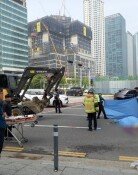Meditation Time at Temple

Right now, after the hype of summer and Chuseok has died down a bit, its time for some meditation. In just two days it will be October and well be heading for years-end.
We found the travelers destination with the least people, the furthest from Seoul, down in the country where autumn creeps upon the land faster - Bonghwa, Gyeongbuk. Bonghwa has always been known for its detachment factor since the old days when it was the retreat for Seoul scholars.
○ First stop, the retrospective Cheongryangsa (Cheongryang Temple).
The inside of the sanctuary and in front of the pagoda are popular places for meditation.
So answered the head priest of Cheongryangsa, Seokjihyeon, when asked where the best place was for meditation. He added, Theres no set time and place for retrospection. Even taking five minutes everyday before bed for reflection reduces the quakes of a wavering mind. He also remarked that the time for retrospection should gradually increase to 20, 30 minutes.
Cheongryangsa is located in the Mt. Cheongryang Provincial Park. Unlike other temples, it is situated on the very steep and bolderous slope. The mountain peaks that surround the temple offer superb scenery. At the entrance, a teahouse adds to the cozy atmosphere.
Around this time of year, a Sansa Music Concert is held on a balmy autumn night. This year Korean classical musician Jang Sa-ik will be invited on October 6, 7:00 p.m., to perform under the theme Starlight Excursion. When such a concert opens, the slope overflows with people from all across the nation.
There are a few rooms at the temple, but theyre only open to worshippers. Cheongryangsa. For more information, call 054-672-1446.
○ Following the state highway 35 from Cheongryangsa into Chunyang, youll find the antiquated mountain house built in 1878 (15 years into the Emperor Gojong regime). The house is still inhabited by the 5th generation descendants of Kang Baek-gi (62).
Sitting across from Chunyang Elementary School, this house is famous for retaining all of its Joseon-style glory. You can enjoy a sense of timelessness with all the other antiquated houses and pavilions scattered around this area.
Bonghwa is also the place where five scholars settled after fleeing from Seoul, unable to tolerate the shame of the Manchu War of the Joseon Dynasty. Their predecessors are still carrying out the tradition of gathering today, naming the assembly Waseonjeonggae, after the pavilion.
Entering the tall gate set between the servants quarters of the antiquated mountain house, there lies a spacious courtyard. On the right there is a separate house called Chillyuheon, enshrouded by a fence, and to the left theres a study. The three-room Chillyuheon, with an open wooden floor, is open to outsiders who wish to spend a night at the historical house. Artists and others who love the old house frequent these rooms.
Bonghwa still brims with much of its genuine old-fashioned warm-heartedness. If you visit in late September or early October, when the pine mushroom is in full bloom, you can enjoy all-organic pine mushrooms in your ramen at no extra cost. Its a neighborhood that stores away not-for-sale mushrooms for its families and then dishes them out to guests to reward them for making the effort to come way out here.
The Kang couple also lets out the 400-pyeong Chillyuheon for guests. With three rooms, two to three families can spend the night together. To pay off management expenses, they charge 100,000 won for room and board. Although this beats the price of any other place, the couple says they still feel awkward receiving money (contact number: 054-672-3206).
○ Ten minutes out of the historical house by car, past the Bonghwa herb plantation, theres a famous Geumgang pine tree forest. Since the fall of 2006, the forest has been open to the public for the first time. Upon entering the forest, you are engulfed in the fragrance of 60 to 80-year-old strapping pine trees.
The Geumgang pine tree is said to be one of the best specimens in the world. Its also called the beauty pine for its smooth length, the red pine for its bay-colored bark, hwangjang tree for its golden inside, and chunyang tree for its origin in Chunyang, among many other names.
The Geumgang pine tree casts away its own branches. As it grows, the branches on the lower side become desiccated and fall off naturally. It leads a well-organized life, taking care of itself.
The forest is busy expanding. You can see the thinned-out trees that let sunlight in, and the cleared land on which new pine seedlings grow.
It takes about an hour to walk the 1.5-kilometer path through the forest while listening to the guide, Lee Gwi-mae. Lee said brightly, City folks who believe in the healing powers of the forest travel great distances to see this place. There arent many convenience facilities around because it hasnt been open for long.
If you call the Yeongju National Forest Office (054-635-4253), they can set you up with a guide.
Theres also the fun of seeing the apple trees all around Bonghwa-gun. You can enjoy the well-known steamed rice with pine mushroom, the herb-marinated beef, or the Bongseong barbequed pork.
Right now in Bonghwa-gun the Chunyang Pine Mushroom Festival, which will run from September 29 to October 3, is in its final preparation stages. Enjoy various events like building a Korean-style house with the chunyang pine tree lumber, or try your hand at picking those delectable pine mushrooms.
jameshuh@donga.com sannae@donga.com






